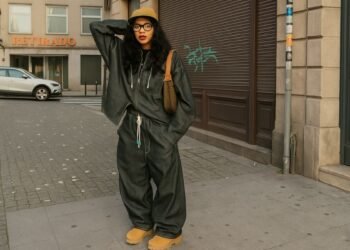You might already be aware of this, but the economic boom that followed World War II meant that individuals had more money to spend and wanted elegant new fashions. The resurgence of fashion is another byproduct of the current economic upswing.
The “make do and mend” mentality of the 1940s was nearing its end. Along with it came a new collection of colourful apparel, elegant shoes, and accessories that were all brought to the forefront in the 1950s as a decade.
Things got a lot more fun for the summer, including 1950s swimsuits. It was more socially acceptable to expose more flesh, and certain things and a fashionable look were supposed to assist women in satisfying their spouses or helping them land one.
In addition, women were encouraged to display more skin. Many women got ideas for their wardrobes from movies and television series, as well as from the actresses who played the lead roles in such shows and films, and from the clothes and hairstyles that their characters wore.
Jump Link
Summer Dress-Up
In 1950, the same colourful and pink block cotton dresses that were quite popular in the spring were also very popular in the summer. These dresses had a skin-tight bodice nipped at the waist and a full circle skirt.
These would be colour-coordinated with shoes, handbags, and even parasols, which I like having done with other accessories like this. Women’s summer dresses were often sleeveless so they could feel comfortable in the heat without sacrificing their sense of style.
In addition, many women donned clothes with nautical themes, including colours and embellishments. The combination of navy, crimson, and white was used for more than just the yacht’s colour scheme. Additionally, it was worn daily, in addition to going to picnics, the beach, and even a few evening activities.
Petticoats were worn when it was very warm outside. This resulted from the societal norms of the day and the need to have that circular skirt draped appropriately.
Summer Footwear
In contrast to the 1940s, the summer shoe trend of the 1950s included a wider variety of colours and strap designs to choose from. This was the most notable change. The wedge heel that was so popular in the 1940s remained to be worn, but it was eventually modernized into the platform wedge.
There was no predetermined design for the straps; they may be broad or narrow, and there could be few or many buckles. Variety could be found in every nook and cranny, including the kinds of materials and textures used to craft summer shoes.
Sandals crafted from braided straw, rope, and raffia were popular as a direct result of the popularity of tropical holidays during this period. Embroidery was also used to decorate accent portions of the footwear, and it was typically designed to coordinate with a motif used elsewhere on the garment.
Beach sandals
It wasn’t just wedged that were all the rage at that time. Flat beach sandals were also popular since they were more convenient to wear in sandy places with uneven terrain. This type of footwear had a very flat sole and included multiple straps that crossed over the upper part of the foot and wrapped around the heel. These straps might be thick or thin and were available in any colour.
In keeping with the persistent preoccupation with the present, many styles of flat sandals took their cue from the technology of the space age and featured a single bar all across the toe or a single wide strap running up the middle.
Day-to-day footwear
Regarding day-to-day footwear, women continued to like heeled wedges or platforms to wear with summer dresses and skirts. Wedges with two broad colour straps, crepe rubber bottoms, and cutouts were fashionable and widespread in their appeal.
At this time, sandals began to be constructed out of more casual and sporty materials, such as canvas, denim, and cotton twill, making them easier to clean.
Summer Swimsuits
The materials used to make swimsuits in the 1950s were considerably different from those often used to make swimsuits now, even though this was an improvement from the fabrics used in the 1940s. Jersey fabric was modified with nylon and elastic to stretch more easily and dry quickly after being wet. Additionally, advancements were made to the rubberized material known as Lastex during the 1940s.
In the 1950s, the majority of swimsuit materials consisted of this cotton, acetate, and taffeta, along with other fabrics.
In the past, bathing suits were constructed from a knitted fabric, which resulted in a somewhat bulkier sensation than the modern thin lycra suits. An effort was made to design swimsuits that contoured the body but concealed any lumps and bruises that may have been there.
Summary
The summer heat might be oppressive, but you can maintain your style by dressing in a chic and vintage-inspired manner while keeping cool. By becoming familiar with the dominant trends of the 1950s decade, you will be able to make it simple to procure modern reproductions and authentic vintage items and even create your outfit.
Have a good day!




